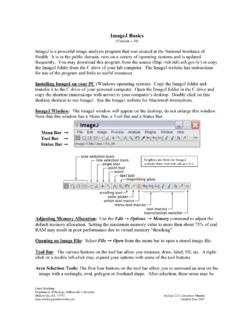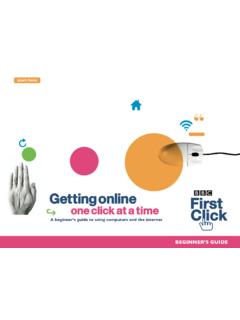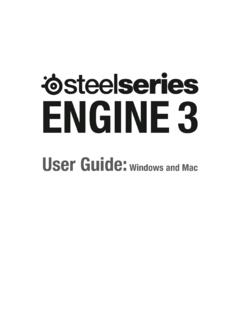Transcription of Basic Keyboarding - SCPL
1 1 Basic Keyboarding Introduction to the Computer keyboard Location: Central Library, Technology Room Visit Schenectady County Public Library at 2 Sitting at the Controls A driver sitting behind the wheel of a car for the first time will adjust the seat, mirrors, and scan the car s dashboard before going down the highway. You will want to make sure you are comfortably positioned to use your computer controls before starting your journey on the electronic highway. keyboard Height: upper arms should not have to extend very far forward to reach the keyboard or the mouse. The forearms should be approximately parallel to the floor when keying. There should be no more than a very slight reach up or down. If the keyboard is too low, your shoulders and arms will become tired. Distance from the keyboard : one hand-span. Hand-span tells you how far you should sit away from your keyboard .
2 If you sit too far away, you will not be able to reach the keys above home row. If you sit too close, you will not be able to reach the keys below home row. Positioning Yourself: feet flat on the floor. They help balance your body for Keyboarding . Crossing your ankles or knees puts a strain on your spine. Sit up straight to keep your spine straight and comfortable as well as provide balance. Elbows in will help keep fingers positioned on the home row. Wrist Position: slightly curve your fingers as they rest on the home row keys. Don t raise your palms so much that your wrists arch. Maintaining proper wrist position helps avoid fatigue in your hands. If you wrists rest on your keyboard , this will cause you to make typing mistakes. Eyes on Copy: just like a driver keeps his eyes on the road, you will make fewer mistakes if you learn to keep your eyes on what you want to type.
3 Fingers Anchored: rest your fingers on the home row keys. When you reach for a key on the top or bottom row, remember to bring your fingers back to the home row position. Lighting and Your Eyes: people tend to stare at the computer screen without blinking. Make sure you blink while at the computer to minimize your risk of dry-eye syndrome. Adjust the height and angle of the monitor (if possible) for comfortable viewing and to reduce screen glare. 3 Fingers on the keyboard Your computer needs you! Without your nimble fingers to give it commands, it will just be something else to clutter your desk. The keyboard , the mouse, and your fingers work together to tell the computer where you want to go for information and to express your thoughts in the documents you create. Many people never learn to type and use a two-fingered hunt and peck method (also called hunt and hope or peck and pray).
4 However, that leaves eight other fingers wondering what to do. A Typical PC keyboard : keyboards will vary from manufacturer to manufacturer but generally have four areas: Function Keys, Typewriter Keys, Cursor Control Keys, and Numeric Keypad. Function Keys Typewriter Keys Function Keys: these keys are assigned a special task or function. Here is a sample of common function keys and associated tasks. F1 Get Help or visit Microsoft Office Online F5 Find and replace F7 Choose the Spelling command (Review tab) F8 Usually used with LCD projector/dual monitor device. F10 Show Key Tips F12 Choose the Save As command (Microsoft Office Button) F keys are also used in combination with the Shift, Alt, and Ctrl keys. (For a list of Function keys and combination commands, click Help feature of your program. Enter shortcut keys. Click keyboard shortcuts for Microsoft Office.)
5 Typewriter Keys: letters, numbers, and punctuation keys. Additional keys include the space bar, shift key (for capital letters and top symbol on keys), and Caps Lock key for a series of capital letters. Press the Enter key to begin a new paragraph in a word processor program (also Numeric Keypad Cursor Control Keys 4 the same as clicking the OK button in a dialog box) The Spacebar separates a series of letters and /or numbers into Standard English text. Cursor Control Keys: also called arrow keys, which move your text cursor in the direction of the arrow. Numeric Keypad: similar to a calculator for entering numbers and doing mathematical operations quickly and easily. (You may also have a calculator shortcut key on your keyboard .) What about all the OTHER keys? Combination Keys: The Shift key is used to make capital letters or to access the punctuation and other symbols on the number keys and other keys.
6 (Also used in combination with function and/or ctrl keys.) The Alt key is used in combination with the command keys for special functions such as Ctrl+Alt+Dlt for task manager or ALT+F4 Exit Office Word 2007 Control key used in combination with other command keys. CTRL+F10 will maximize the document window. Locking Keys: these keys change how certain parts of the keyboard respond and can make your task easier (or make you wonder what in the world happened!) For each key you click, a small light will appear usually on the top right of the keyboard . To turn off a key, just click it again. Think Capital letters. The Shift key is used for a single capital letter and the Caps Lock could be used for emphasis or to create a title. ( If you press the Shift key while the Caps Lock is on, the letters will return to normal.) Pressing this key activities the numeric keypad at the right of the keyboard .
7 Press the key again to turn off the Num Lock and you can use the arrow keys on the 2,4,6,8. 5 Originally, it was meant to make the arrow keys scroll the contents of a text window instead of moving the cursor. Navigation keys: Arrow keys, Page Up/Page Down, Home, and End are convenient to move your cursor to the desired location. Oooops! Keys Deletes text to the left of the cursor for each time you click on the key. Deletes text to the right of the cursor for each time you click on the key. Or click and drag your cursor over a line(s) of text to select the text and click Delete. All the selected text will be deleted. Helpful Keys Windows key. Shortcut for the start menu. PrtScn/SysRq Print Screen - pressing print screen will capture the entire screen, while pressing the alt key in combination with print screen will capture the currently selected window. Esc Escape shortcut in dialog boxes for No, Quit, Exit, Cancel, or Abort, as well as a common shortcut key for the Stop button in many web browsers.
8 Menu key - The key's symbol is a small icon depicting a cursor hovering above a menu. The key's primary function is to launch a context menu with the keyboard rather than with the right-mouse button 6 keyboard Whiz Knowing Where to Put Your Fingers It is not absolutely positively necessary to use all ten of your fingers on your keyboard . You can learn where all the alphabet and punctuation keys are and continue with the two-finger approach. But - it certainly makes a certain amount of sense to get those other eight fingers working for you for speed and accuracy. The basics of Typing ` 1 2 3 4 5 6 7 8 9 0 - = Backspace Tab Q W E R T Y U I O P { } | Caps A S D F G H J K L ; " Enter Shift Z X C V B N M < > ? Shift Space bar - use right hand thumb Home row keys: Left hand: A S D F A - little finger S - ring finger D - middle finger F - forefinger Right hand: J K L ; J - forefinger K - middle finger L - ring finger ; - little finger Thumbs of both hands are on space bar Familiarity with the keyboard will increase your confidence that you are the master at the controls.
9 Here are websites with keyboard lessons, paragraph writing, and games for the inexperienced as well as experienced typist looking to update their skills. 7 Click typing lessons-Qwerty. Click on lesson you would like to try (lessons 1-13). Click Start to begin. You should see a blinking I-beam in the text box on the bottom of the window. ( If there is not blinking I-beam, click in the textbox.) Place your fingers on the home row and begin typing the letters on the screen. Be sure to click the spacebar! There are also Typing Tests, Practice, and Games. Something for all ability levels! Click Typing Tutorials. Click on the lesson of your choice. Click Start. Place your fingers on the home row and begin typing. If you make an error, the program will show you the hand and finger of choice. Keypad Tutorials work with the number keypad for those who have to enter numerical data.
10 Both programs will give you your words per minute , number right, number wrong and your practice time. 8 27 guided practice lessons, but you must register in order to use the program. Other interesting websites: Peter s Online Typing Course. Simple but packed with good points to know and practice exercises. (Note: when the directions say hit the button they mean hit the keyboard letter that matches the first letter of the exercise. As you type, the letters will disappear . ) Free typing games, lessons, and tests with scoreboard feature. Enjoy the games while you practice! This program wants you to register to keep track of your progress, but you can still use it without registering your scores will not be saved. Excellent. Simple but clear explanation of QWERTY keyboard and keyboard shortcut keys.










